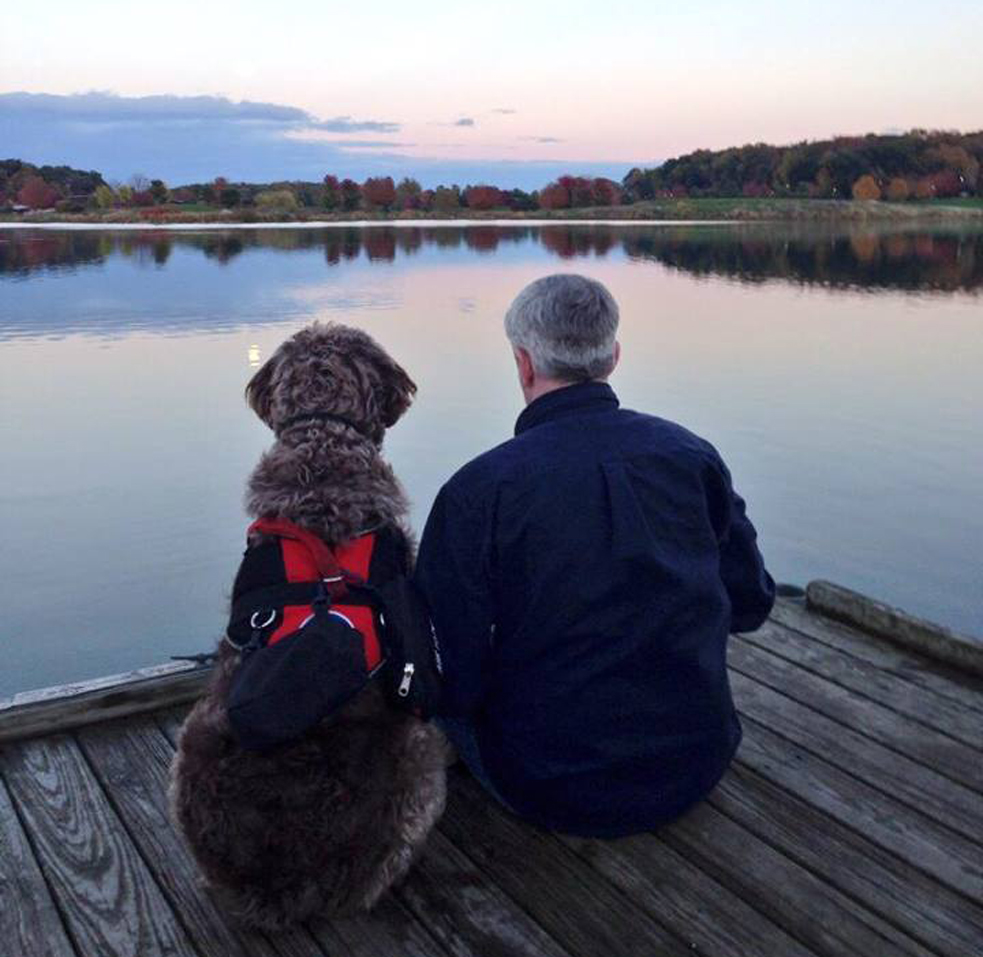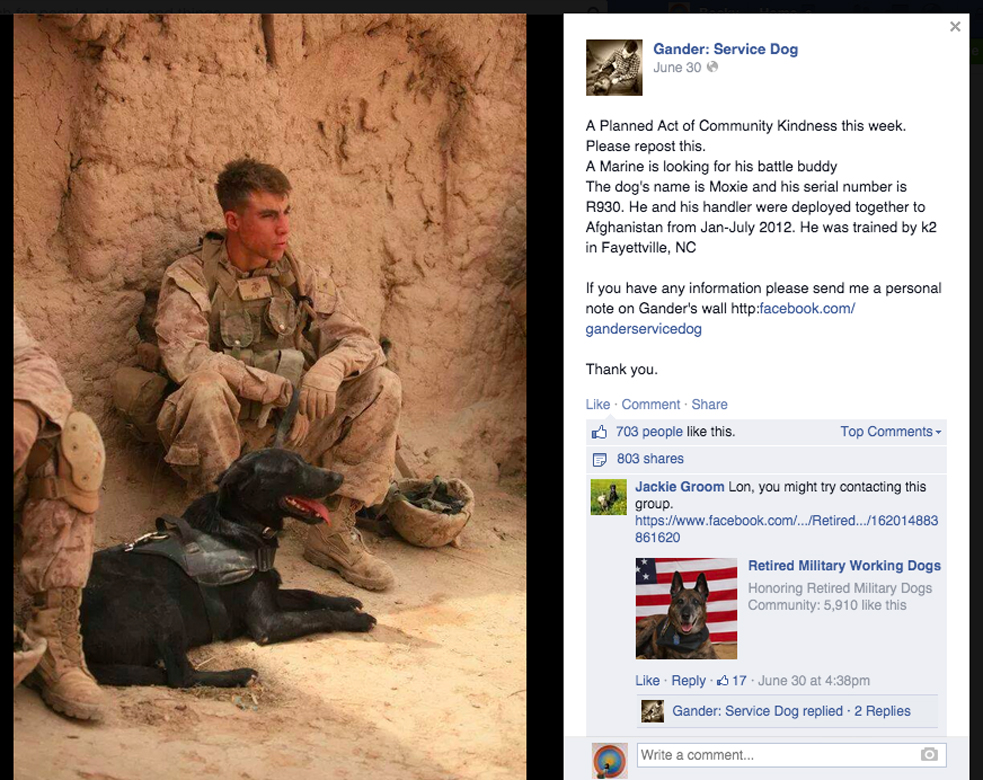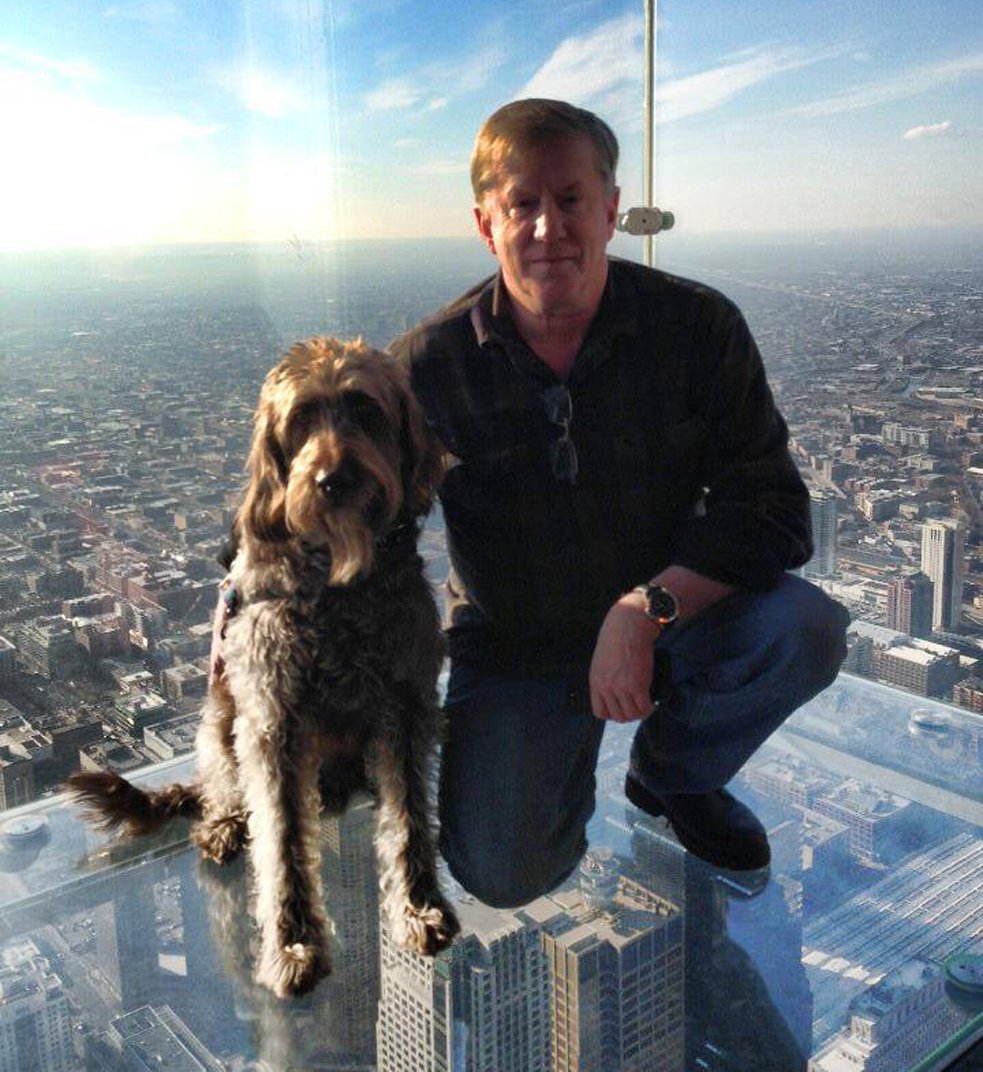
Lon Hodge and his service dog, Gander, go everywhere together. After decades of living with debilitating PTSD, Gander is helping Hodge step back into the world. Photo: Courtesy of Lon Hodge
Lon Hodge and his labradoodle, Gander, are at a McDonald’s near the Naval Station Great Lakes in Illinois, a quick stop for a bite as they travel across the United States. “He never leaves my side,” Hodge explains to a curious woman, patting Gander on the flank. “He’s special.”
Hodge and Gander are on the road interviewing the families of US veterans who committed suicide; the result will be a book, Fetch, which he aims to self-publish early next year. Hodge, a TEDActive attendee, is a veteran and one of the 5.2 million adults in the US who have post-traumatic stress disorder. Gander, also a friendly face at TEDActive, is the service dog who saved his life.
Hodge served in the military from 1973 to 1981, working in the medical corps. When he transitioned from military to civilian life, his PTSD was a quiet, slow-burning fuse — that went off with no warning. He woke up one day, two years after his service, crippled by anxiety, afraid to step outside his house. “I was completely, horrifyingly debilitated,” Hodge remembers. During the day, he had multiple panic attacks. At night, he battled nightmares. Hodge’s resting heart rate teetered on a dangerous 120 beats per minute, but there was nothing wrong with his heart, the cardiologist told him; it was his mind that was doing him in. Hodge was trapped in an all-consuming inferno of his own memories.
“Imagine yourself standing on the edge of a balcony on a high building,” he says. “You know that jolt like maybe you might fall over? Now multiply that feeling by four and experience that all day, every day.” He knew he had to make a change, before he lost his footing and fell. He began taking benzodiazepine, a psychoactive drug prescribed by the military doctors and lived in a “fog” for the next decades.
The turning point: one day in 2012, Hodge stumbled on a TV special about service animals. Inspired, he contacted Freedom Service Dogs in Denver, a nonprofit that trains rescue dogs to work with veterans as well as with children, the elderly and the disabled. He went in for a consulting session, where he was introduced to all kinds of dogs, from Burmese mountain dogs to Labradors. Seven months later, he was matched with a Lab-poodle mix named Gander who had been rescued from a shelter and trained by a woman at a Colorado correctional facility. Hodge and Gander met up in Denver, spent the day bonding, then snuck off at night to play ball in nearby Red Rocks Park. They knew it would work. On September 20, Hodge and Gander drove back home to Chicago.
Their new life together was not without growing pains. Hodge admits the first few months were intensely stressful. “A service dog is the first public evidence that there’s something wrong with you,” he says. “A million questions arise.” People would poke and prod about his “condition” and ask why it wasn’t more visible. Hodge had to explain to no-dogs-allowed businesses that service dogs were by law considered medical equipment. But despite these struggles, things were getting better. His heart rate dropped back to 80bpm, and the suicidal thoughts and anxiety shrank from a boil to a simmer. Hodge slowly and cautiously stepped out into the world again with Gander by his side.

Gander is a labradoodle—but also a friend to Hodge. Photo: Courtesy of Lon Hodge
Hodge first discovered TED in 2010, before Gander even came into the picture. Excited by the idea of joining a community of individuals hungry for ideas, Hodge decided to take a chance on attending TEDActive. He admits he was terrified, but he was comforted in knowing Gander would be right there with him. In spring of 2013, the two braved a trip to Palm Springs to experience a week of TED Talks with over 800 people from all over the globe.
Although they shied away from the larger gatherings at the conference, Hodge and Gander found plenty of opportunities to create their own memorable moments by socializing in smaller sips and taking time to decompress. Hodge spoke with artist and TED Fellow David Gurman about his project The Nicholas Shadow, in which he connected a data feed from the Iraq Body Count project with a bell in a church in San Francisco so it would toll for every civilian death for the day. Hodge began to think about ways to commemorate veterans who committed suicide, and the idea for Fetch was seeded. “I came out infinitely stronger than when I went in,” he says. Hodge credits TEDActive for helping him feel more comfortable in public functions.
When they returned home, Gander was nominated for the American Humane Association Hero Dog Awards, a prize that would come with a grant for Freedom Service Dogs so they could match more veterans with service dogs. To drum up votes and win that grant, Hodge created a Facebook page, a Twitter account and a blog to share stories and photos of his and Gander’s journeys together.
Hodge and Gander didn’t win the competition, but their fan base flourished. Today, they have over 240,000 Facebook fans and 75,000 Twitter followers. (And this year, Gander took home the prestigious AKC Humane Fund Award for Canine Excellence in the service dog category.) Hodge wanted Gander’s sites to be a “safe haven” for any veteran going through trauma, or anyone who knows someone who was. All members are required to be kind and civil.

Hodge and Gander at work on their book, Fetch. Hodge raised money to fund the project with an Indiegogo campaign. Photo: Courtesy of Lon Hodge
Hodge answers each of the 60 or so messages that he and Gander receive daily, which can range from specific advice on how to get a service dog for a particular trauma, to a teacher wanting to learn more about service dogs in general. Hodge noticed many people write about how hard it is to find other people who are going through PTSD—the invisibility of the disorder makes it especially deadly. “We don’t like to show that we’re flying apart at the seams. So we might appear reasonably normal,” says Hodge. “But inside, I’m winding up with anxiety, ready to blow up at any second.”
Then, the depression hits, he says. And at that point, “You think being dead would be a whole lot better than this. You carry suicide in your pocket and say, ‘I’ll use this one day.’”
The Department of Veteran Affairs estimates that 22 veterans take their lives every day. But Hodge wants people to look beyond the number and understand that these lives are casualties of war, in which the battles are fought alone and within.
“Most of the time when someone commits suicide, we’re afraid to talk about it. We don’t want anyone to think our son or brother or daughter or sister was defective. But that’s exactly why it keeps happening,” he says. Hodge hopes to change the conversation from death and statistics to a celebration of a life cut short as he collects stories for Fetch.
So far on their journey around the country, funded by an Indiegogo campaign, Hodge and Gander have met more than a thousand of their fans in person. They’ve visited patients in hospitals, spoken in schools and businesses about service dogs, and visited cemeteries and monuments to give rites at the gravesites for people in their online community.
On Gander’s Facebook, Hodge initiates PACKs—Planned Acts of Community Kindness—in which he publicizes a request from a member of the community and turns it into a group action. For example, one woman requested that the community send her veteran father birthday cards for the week of his leg amputation. He received over 100 cards from 16 different countries.

Hodge recently helped Marine Corps Lance corporal Dylan Bogue find the bomb-sniffing dog he worked with in Afghanistan, Moxie. Photo: Facebook
Recently, Hodge and Gander helped Marine Corps Lance corporal Dylan Bogue reunite with his black Labrador, Moxie, a bomb-sniffing dog who’d been separated from him after seven months of working together in Afghanistan. Hodge launched a PACK to try to find Moxie. It went viral. A month later, a community member called Bogue and told him Moxie was working as a bomb dog for the Massachusetts Bay Transportation Authority, Boston’s famous T. When the MBTA got wind of the story, they offered Moxie to Bogue without hesitation — and handed him over in a moving ceremony. Wounded Warriors flew Bogue to Boston, and the Boston Red Sox—another connection created by a member of Gander’s Facebook group—invited Bogue to throw out the first pitch in a baseball game at Fenway. Hodge and Gander enjoyed the game from the bleachers, after giving away their box seat tickets to Moxie’s previous owner, police officer Chip Leonard, so he could sit with Moxie and Dylan.
 Laurel Braitman: Depressed dogs, cats with OCD — what animal madness means for us humans
In her recent TED Talk, “Depressed dogs, cat with OCD—what animal madness means for us humans,” science historian Laurel Braitman shares her research on mental illnesses in animals. One big point: Relationships between animals and humans can, it appears, help relieve symptoms of mental distress in both. Braitman talks about Hodge and Gander’s friendship, sharing a story of how Hodge’s fear of heights, developed during drills rappelling from helicopters, somehow manifested in Gander too.
Laurel Braitman: Depressed dogs, cats with OCD — what animal madness means for us humans
In her recent TED Talk, “Depressed dogs, cat with OCD—what animal madness means for us humans,” science historian Laurel Braitman shares her research on mental illnesses in animals. One big point: Relationships between animals and humans can, it appears, help relieve symptoms of mental distress in both. Braitman talks about Hodge and Gander’s friendship, sharing a story of how Hodge’s fear of heights, developed during drills rappelling from helicopters, somehow manifested in Gander too.
Paradoxically, Braitman believes that Gander’s phobia actually makes him a better service dog, because he challenges his owner to be fearless. “Now, when they’re both at a great height, Lonnie is so concerned with Gander’s well-being that he forgets to be scared of heights himself,” she says.
Braitman met Hodge and Gander at TEDActive, and after hearing their story, became a part of their online community too. It’s a community that, Hodge admits, he never actually wanted. He recalls how terrified he was to be in the public eye, but with Gander came a new purpose—the opportunity to educate others on the importance of service dogs, PTSD, trauma and suicide. Long after he’d served in the military, but before his PTSD became crippling, Hodge had been a literature and culture teacher in China—and the community that formed around Gander helped him take on a public leadership role once again. The dozens of questions he gets daily no longer bother him.
“With PTSD, it’s hard to lift your head above your anxiety,” he says. “Gander breaks down your defenses. I’ve come back to myself and I’ve come back to the belief that the world is filled with a lot of good people. I want to be the person my dog thinks I am.”

Both Hodge and Gander are scared of heights—but together they face their fear. Photo: Courtesy of Lon Hodge
Comments (6)